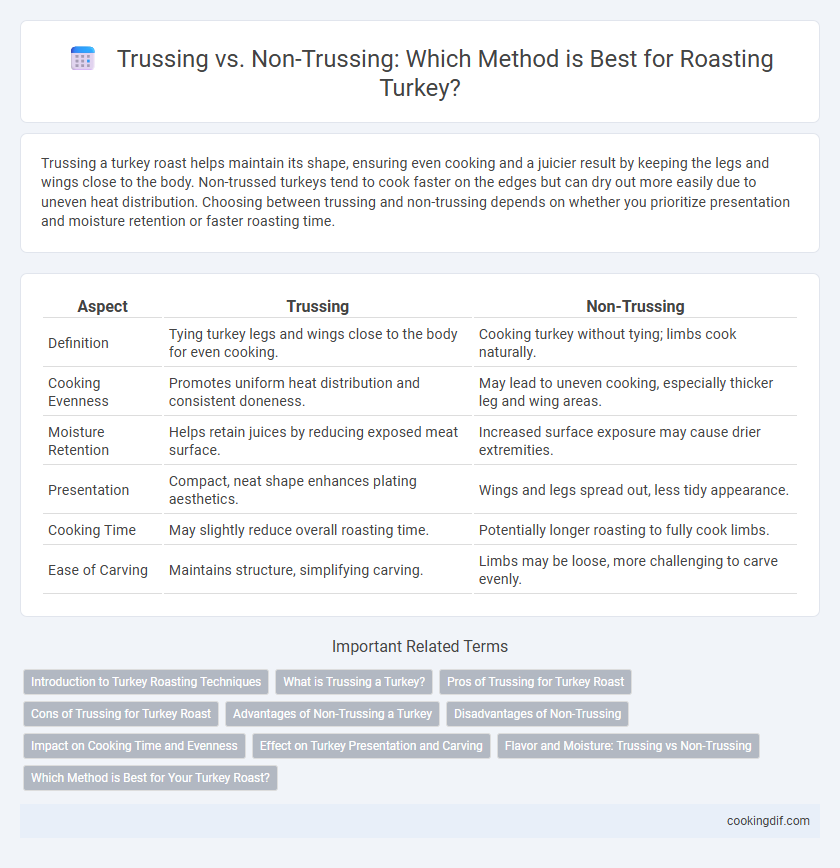Trussing a turkey roast helps maintain its shape, ensuring even cooking and a juicier result by keeping the legs and wings close to the body. Non-trussed turkeys tend to cook faster on the edges but can dry out more easily due to uneven heat distribution. Choosing between trussing and non-trussing depends on whether you prioritize presentation and moisture retention or faster roasting time.
Table of Comparison
| Aspect | Trussing | Non-Trussing |
|---|---|---|
| Definition | Tying turkey legs and wings close to the body for even cooking. | Cooking turkey without tying; limbs cook naturally. |
| Cooking Evenness | Promotes uniform heat distribution and consistent doneness. | May lead to uneven cooking, especially thicker leg and wing areas. |
| Moisture Retention | Helps retain juices by reducing exposed meat surface. | Increased surface exposure may cause drier extremities. |
| Presentation | Compact, neat shape enhances plating aesthetics. | Wings and legs spread out, less tidy appearance. |
| Cooking Time | May slightly reduce overall roasting time. | Potentially longer roasting to fully cook limbs. |
| Ease of Carving | Maintains structure, simplifying carving. | Limbs may be loose, more challenging to carve evenly. |
Introduction to Turkey Roasting Techniques
Trussing a turkey involves tying the legs and wings close to the body to ensure even cooking and maintain shape during roasting, which helps retain moisture and results in tender meat. Non-trussing allows the bird to cook more freely, potentially creating crisper skin but may lead to uneven cooking or dryer meat in certain areas. Understanding the balance between trussing and non-trussing techniques is essential for mastering turkey roasting and achieving optimal texture and flavor.
What is Trussing a Turkey?
Trussing a turkey involves tying the legs and wings close to the body using kitchen twine to ensure even cooking and maintain a compact shape. This technique helps prevent the extremities from drying out and promotes uniform browning during roasting. Without trussing, the limbs may spread out, potentially leading to uneven cooking and a less visually appealing presentation.
Pros of Trussing for Turkey Roast
Trussing a turkey roast ensures even cooking by keeping the bird compact, which promotes uniform heat distribution and moisture retention. It helps maintain an attractive shape, preventing the wings and legs from overcooking or drying out. The tied turkey also facilitates easier handling and carving after roasting, enhancing presentation and serving efficiency.
Cons of Trussing for Turkey Roast
Trussing a turkey roast can restrict even heat circulation, leading to uneven cooking and potentially undercooked areas, especially in the thicker parts. It also limits the skin exposure, reducing the ability to achieve a uniformly crispy, golden-brown exterior. Furthermore, trussing may trap moisture and steam, preventing optimal browning and resulting in less flavorful, soggier skin.
Advantages of Non-Trussing a Turkey
Non-trussing a turkey roast allows for more even heat circulation, promoting a uniformly crispy skin and juicier meat. This method reduces the risk of overly dense breast meat and helps the bird cook faster by exposing all parts to heat. Non-trussing also simplifies preparation, making it easier to season and baste effectively during roasting.
Disadvantages of Non-Trussing
Non-trussing a turkey roast often results in uneven cooking, with the breast meat drying out while the legs remain undercooked. Lack of trussing also causes the bird to lose shape, leading to a less uniform presentation and difficulty in handling during roasting. This can increase the risk of uneven heat distribution, affecting overall texture and flavor quality.
Impact on Cooking Time and Evenness
Trussing a turkey roast helps maintain a compact shape, promoting more even cooking and reducing the overall cooking time by minimizing exposed surface area. Non-trussed turkeys tend to spread out, resulting in uneven heat distribution and longer cooking times, potentially causing dry edges and undercooked inner meat. Proper trussing enhances moisture retention and ensures consistent doneness throughout the bird.
Effect on Turkey Presentation and Carving
Trussing a turkey roast ensures a uniform shape that improves oven heat distribution, resulting in even browning and a compact presentation ideal for serving. Non-trussed turkeys tend to spread out during roasting, creating an irregular shape that may complicate carving and produce uneven slices. Optimal presentation and ease of carving are achieved through trussing, as it maintains meat tenderness and structural integrity.
Flavor and Moisture: Trussing vs Non-Trussing
Trussing a turkey roast helps retain moisture by keeping the bird compact, allowing even heat distribution and preventing the breast meat from drying out. Non-trussing allows for better air circulation, which can result in crisper skin but may cause uneven cooking and moisture loss in some parts. Flavor intensity can be enhanced with trussing as the juices stay concentrated within the compact roast, while non-trussed turkeys often develop more pronounced outer seasoning due to greater surface exposure.
Which Method is Best for Your Turkey Roast?
Trussing a turkey roast helps maintain even cooking by securely tying the legs and wings close to the body, preventing overcooked extremities and promoting uniform heat distribution. Non-trussing allows for more exposed surface area, leading to crispier skin but may result in uneven cooking or drying out of thinner parts. Choosing between trussing and non-trussing depends on whether you prioritize a consistent roast texture or a crunchier skin finish for your turkey.
Trussing vs Non-Trussing for Turkey Roast Infographic

 cookingdif.com
cookingdif.com